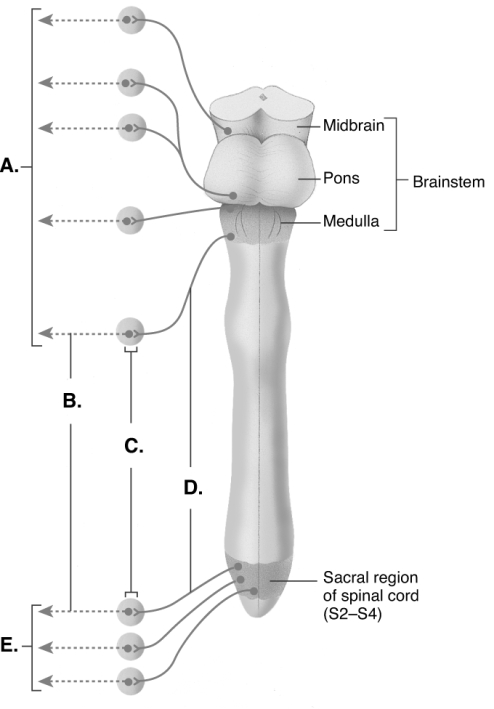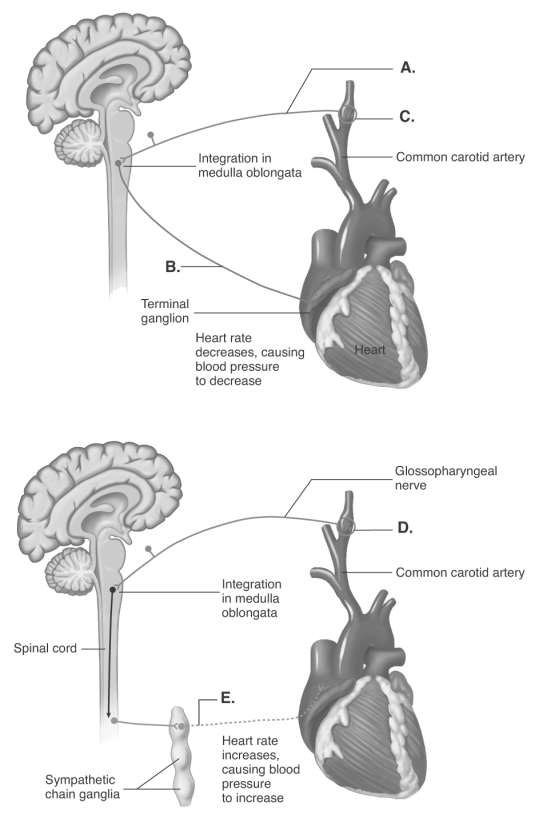A) constriction of the pupils of the eye
B) contraction of the urinary bladder
C) decreased heart rate
D) dilation of the bronchioles in the lungs
E) increased gastric secretions
G) C) and D)
Correct Answer

verified
Correct Answer
verified
Multiple Choice
 -The figure illustrates the parasympathetic division. What does "A" represent?
-The figure illustrates the parasympathetic division. What does "A" represent?
A) preganglionic neurons
B) pelvic splanchnic nerves
C) cranial nerves
D) postganglionic neurons
E) terminal ganglia
G) A) and E)
Correct Answer

verified
Correct Answer
verified
Multiple Choice
Adrenergic receptors
A) can be activated by the release of epinephrine.
B) have two structural forms - muscarinic and nicotinic.
C) when activated stimulate skeletal muscles to contract.
D) can be found in both the sympathetic and parasympathetic divisions.
E) are activated by the release of acetylcholine.
G) D) and E)
Correct Answer

verified
Correct Answer
verified
Multiple Choice
Consider the two statements and use the following key to choose your answer. -(1) the frequency of sympathetic impulses to the heart when blood pressure increases (2) the frequency of sympathetic impulses to the heart when blood pressure decreases
A) Choose this if the first item is greater than the second item.
B) Choose this if the first item is less than the second item.
C) Choose this if both items are equal or nearly equal.
E) None of the above
Correct Answer

verified
Correct Answer
verified
Multiple Choice
Which of the organs listed below is not directly innervated by the autonomic nervous system?
A) the heart
B) sweat gland
C) smooth muscle
D) skeletal muscle
E) salivary gland
G) B) and E)
Correct Answer

verified
Correct Answer
verified
Multiple Choice
Acetylcholine will cause the pupil of the eye to constrict. A drug acts on receptors for acetylcholine to cause the pupils of the eye to dilate. Nicotine does not bind to receptors in smooth muscle cells of the iris. Therefore, the drug which causes the pupils to dilate is a
A) nicotinic blocking agent.
B) muscarinic blocking agent.
C) a nicotinic agent.
D) a muscarinic agent.
E) an adrenergic agent.
G) A) and B)
Correct Answer

verified
B
Correct Answer
verified
Multiple Choice
Parasympathetic ganglia are called ____ ganglia.
A) pelvic
B) chain
C) collateral
D) terminal
E) dorsal
G) B) and C)
Correct Answer

verified
D
Correct Answer
verified
Multiple Choice
Match the phrase to either the sympathetic or parasympathetic division of the autonomic nervous system. -inhibits heart rate but stimulates contraction of urinary bladder
A) sympathetic
B) parasympathetic
D) undefined
Correct Answer

verified
Correct Answer
verified
Multiple Choice
Which of the following cranial nerves does NOT carry parasympathetic fibers?
A) glossopharyngeal
B) vagus
C) facial
D) hypoglossal
E) oculomotor
G) A) and B)
Correct Answer

verified
Correct Answer
verified
Multiple Choice
Which of the following drugs would be the best choice to use in chronic asthma to dilate the bronchioles?
A) a nicotinic agent
B) a muscarinic agent
C) alpha-adrenergic blocking agents
D) beta-adrenergic stimulating agents
E) ganglionic blocking agents.
G) B) and E)
Correct Answer

verified
D
Correct Answer
verified
Multiple Choice
Which of the following neurons is most likely to be adrenergic?
A) preganglionic sympathetic
B) preganglionic parasympathetic
C) postganglionic sympathetic
D) postganglionic parasympathetic
E) postganglionic somatic motor
G) All of the above
Correct Answer

verified
Correct Answer
verified
Multiple Choice
 -The figure illustrates the autonomic reflexes and the heart. What does "C" represent?
-The figure illustrates the autonomic reflexes and the heart. What does "C" represent?
A) sympathetic nerve
B) increase in blood pressure detected by carotid baroreceptors
C) glossopharyngeal nerve
D) decrease in blood pressure detected by carotid baroreceptors
E) vagus nerve
G) B) and D)
Correct Answer

verified
Correct Answer
verified
Multiple Choice
The vagus nerve carries parasympathetic impulses to the
A) salivary glands.
B) lacrimal glands.
C) smooth muscle of the eyes.
D) thoracic and abdominal viscera.
E) thyroid gland.
G) C) and E)
Correct Answer

verified
Correct Answer
verified
Short Answer
Axons from preganglionic neurons of the parasympathetic division synapse with _________ ganglia.
Correct Answer

verified
Correct Answer
verified
Multiple Choice
Which of the following statements is false?
A) Both divisions of the ANS can produce stimulatory effects.
B) Both divisions cooperate to achieve normal reproductive function.
C) Structures receiving dual innervation by the ANS are regulated equally by both divisions.
D) The sympathetic division has more influence under conditions of physical activity than does the parasympathetic division.
E) Dual innervation of organs by both divisions of the ANS is not universal.
G) A) and D)
Correct Answer

verified
Correct Answer
verified
Multiple Choice
Match the phrase to either the sympathetic or parasympathetic division of the autonomic nervous system. -fight-or-flight response
A) sympathetic
B) parasympathetic
D) undefined
Correct Answer

verified
Correct Answer
verified
Multiple Choice
Match the phrase to either the sympathetic or parasympathetic division of the autonomic nervous system. -can produce widespread sweating
A) sympathetic
B) parasympathetic
D) undefined
Correct Answer

verified
Correct Answer
verified
Multiple Choice
Match the phrase to either the sympathetic or parasympathetic division of the autonomic nervous system. -functions at rest
A) sympathetic
B) parasympathetic
D) undefined
Correct Answer

verified
Correct Answer
verified
Multiple Choice
Match the phrase to either the sympathetic or parasympathetic division of the autonomic nervous system. -thoracolumbar division
A) sympathetic
B) parasympathetic
D) undefined
Correct Answer

verified
Correct Answer
verified
Multiple Choice
When a person consumes a substantial amount of nicotine, the response
A) increases parasympathetic responses.
B) increases sympathetic responses.
C) decreases parasympathetic responses.
D) decreases sympathetic responses.
E) both increases parasympathetic responses and increases sympathetic responses.
G) C) and D)
Correct Answer

verified
Correct Answer
verified
Showing 1 - 20 of 109
Related Exams